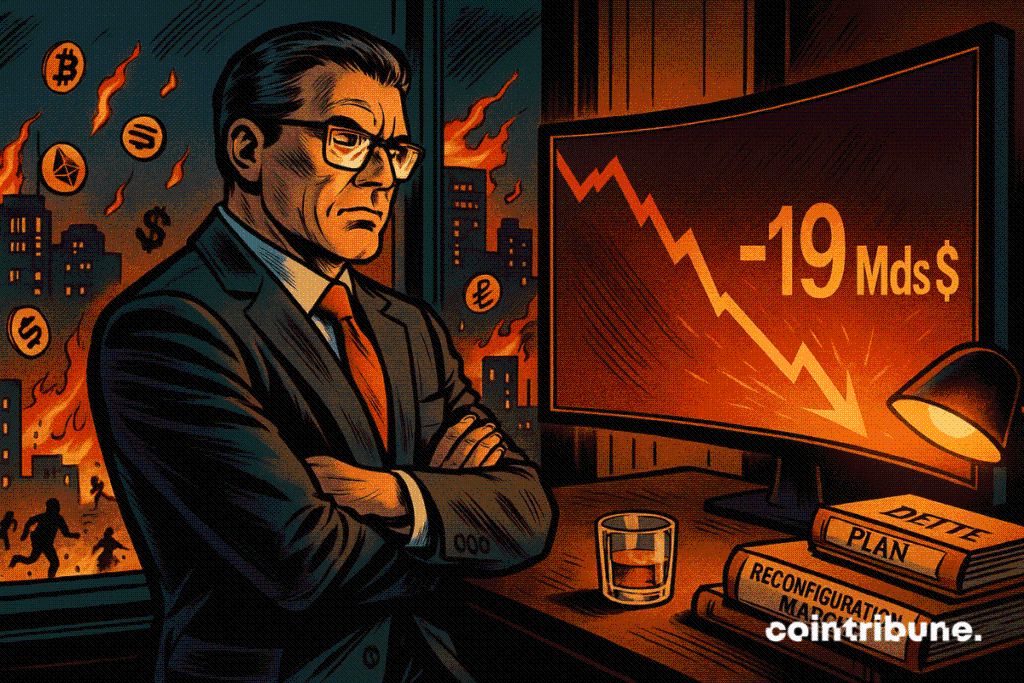During Friday’s crash, spot volume hit $44B (near cycle highs), futures $128B, while OI dropped $14B with only $1B in BTC long liquidations. 93% of OI decline wasn’t forced – this was a controlled deleveraging, not a cascade.
— Axel 💎🙌 Adler Jr (@AxelAdlerJr) October 14, 2025
👉 A very mature moment for Bitcoin. pic.twitter.com/sTrziRUXXo
$19B Vanished : What Really Happened In The Crypto Market ?
By:Cointribune
Summarize this article with:
ChatGPT Perplexity Grok
Last Friday, the crypto market experienced a brutal reversal, with nearly 19 billion dollars of open interest wiped out in a few hours. A correction of such magnitude, even in an ecosystem accustomed to volatility, immediately caught analysts’ attention and revived fears of an uncontrolled collapse. However, behind this spectacular drop, the first analyses reveal a very different scenario, that of a planned deleveraging rather than a generalized panic.

In brief
- The crypto market lost nearly 19 billion dollars of open interest in a few hours, triggering a shockwave in the ecosystem.
- According to several analysts, this was not a cascade of liquidations, but a controlled deleveraging, managed by the actors themselves.
- Other voices raise concerns about the suspicious role of certain market makers, accused of withdrawing their liquidity at the most critical moment.
- Between strategic deleveraging and opaque maneuvers, the event reignites the debate on the resilience of the crypto market to major shocks.
A Massive but Controlled Deleveraging
On Friday, October 11, the crypto market suffered a major decline with nearly 19 billion dollars of open interest liquidated in a few hours.
Indeed, the initial interpretations of the event suggested a cascade of automatic liquidations, a phenomenon often feared during overheated derivatives markets. However, the collected data offers a more nuanced reading, supported by several sector analysts.
Here are the highlights of this sequence :
- Open interest on DEXs : a sharp drop, from 26 billion to 14 billion dollars ;
- According to Axel Adler Jr. of CryptoQuant : “At least 93 % of this drop is the result of a controlled deleveraging, not a liquidation cascade” ;
- Forced liquidations on bitcoin : only 1 billion $ of long positions were liquidated, suggesting a controlled management of leveraged exposures.
For Adler Jr. : “this is a very mature moment for Bitcoin”, referring to the relative stability of traders’ behavior despite the correction.
Following this rebalancing, other economic indicators highlight intense but orderly activity. Fees collected on lending protocols exceeded 20 million dollars in a single day, a historic record.
Meanwhile, weekly volumes on DEXs climbed to 177 billion dollars, while the amount borrowed via lending platforms fell below 60 billion, its lowest level since August. These elements reinforce the idea that the crypto market experienced, this time, a progressive leverage withdrawal rather than an uncontrolled collapse.
A Strategic Liquidity Withdrawal ?
However, this calm reading is not unanimous. Several independent traders and analysts question the idea of a purely mechanical adjustment and point to the role of certain investors who allegedly exacerbated or even caused the crypto crash by withdrawing their liquidity at the most critical moment.
According to the on-chain researcher YQ, these withdrawals began at 9 p.m. UTC on Friday, one hour after Donald Trump’s statement threatening new tariffs. This timing fueled suspicions of a concerted action.
“Market makers started withdrawing their liquidity at 9 p.m., and by 9:20 p.m. most tokens had hit their lows. The market depth collapsed to only 27,000 dollars, a drop of 98%”, he states in a publication on X.
These on-chain data were corroborated by the Coinwatch platform, which also reports a 98 % drop in order book depth on Binance, the world’s largest exchange platform. According to their analysis, two of the three main market makers of a token listed on Binance (valued at over 5 billion $) deserted the order book for five consecutive hours before reactivating their bots.
“When the price dropped, the MMs withdrew everything. 1 hour 30 minutes later, Blue reactivated its bots. Turquoise came back, but minimally”, writes Coinwatch, which also states it is in contact with the involved market makers to “accelerate their return to the order books”.
While these accusations are difficult to formally prove, they raise questions about governance and transparency of crypto infrastructures. The sudden liquidity withdrawal at a pivotal moment, as evidenced by the chaos caused by Trump’s tariffs , could have systemic consequences, notably by weakening investor confidence in the crypto market’s resilience. Going forward, finer monitoring mechanisms and continuous presence obligations for liquidity providers on certain pairs could be considered.
0
0
Disclaimer: The content of this article solely reflects the author's opinion and does not represent the platform in any capacity. This article is not intended to serve as a reference for making investment decisions.
PoolX: Earn new token airdrops
Lock your assets and earn 10%+ APR
Lock now!
You may also like
Bitcoin Updates: Bitcoin Faces 23.6 Fib Level—Could Past Trends Spark an Altcoin Recovery?
- Bitcoin dominance fell to 59% at the 23.6 Fibonacci level, signaling potential altcoin rotation amid ETF outflows and price declines. - Corporate Bitcoin accumulation grows, with Hyperscale Data holding $70.5M in Bitcoin (77% of market cap) and Bitfarms holding $156M in Bitcoin. - Analysts highlight macroeconomic pressures and regulatory uncertainty as constraints on altcoin growth despite technical indicators suggesting capital rotation. - Market focus remains on Bitcoin stabilization above $80,000 and
Bitget-RWA•2025/11/28 18:48

Interoperability Fuels DeFi’s Evolution as Hemi and LI.Fi Connect Blockchains
- Hemi and LI.Fi expanded crosschain interoperability by integrating LI.Fi's bridge and swap API, enabling seamless token transfers across EVM and non-EVM networks like Solana . - Users can now transfer assets like USDC between chains in single transactions using routing tools, reducing friction for DeFi participants and developers. - The partnership standardizes crosschain workflows, eliminating fragmented bridge solutions while supporting liquidity aggregation across EVM, Solana, and alt-VMs. - By stream
Bitget-RWA•2025/11/28 18:48

Vitalik Buterin's Latest Support for ZK Technology and What It Means for the Cryptocurrency Industry
- Vitalik Buterin is driving a blockchain shift via ZK tech, enhancing Ethereum's scalability and privacy. - ZK infrastructure's $28B TVL surge highlights projects like zkSync Era and StarkNet boosting DeFi and gaming. - Investors target EVM-compatible ZK rollups and privacy toolkits, aligning with Ethereum's ZK roadmap.
Bitget-RWA•2025/11/28 18:44

XRP News Today: IMF Cautions That Tokenized Markets Could Face Collapse Without International Cooperation
- IMF warns tokenized markets risk destabilizing flash crashes due to rapid growth and interconnected smart contracts. - XRP highlighted as potential cross-border payment solution but not endorsed, alongside Stellar and Bitcoin-Lightning hybrid models. - Global regulators intensify oversight of tokenized assets, with ESMA, SEC, and central banks addressing governance and liquidity risks. - IMF stresses urgent need for coordinated policy frameworks to prevent fragmentation and systemic vulnerabilities in ev
Bitget-RWA•2025/11/28 18:28

Trending news
MoreCrypto prices
MoreBitcoin
BTC
$90,869.18
-0.96%
Ethereum
ETH
$3,043.2
+0.31%
Tether USDt
USDT
$1
+0.03%
XRP
XRP
$2.17
-2.41%
BNB
BNB
$882.8
-1.65%
Solana
SOL
$137.32
-3.87%
USDC
USDC
$0.9998
+0.01%
TRON
TRX
$0.2808
+0.25%
Dogecoin
DOGE
$0.1496
-2.93%
Cardano
ADA
$0.4194
-3.99%
How to buy BTC
Bitget lists BTC – Buy or sell BTC quickly on Bitget!
Trade now
Become a trader now?A welcome pack worth 6200 USDT for new users!
Sign up now